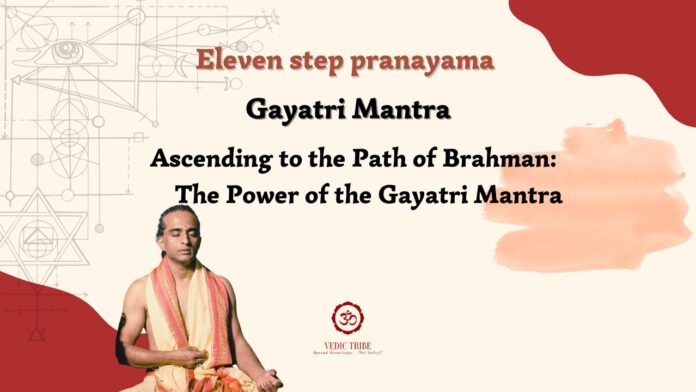In the previous article titled “Eleven-step Pranayama – OM SATHYAM”, we discussed the seventh step i.e., the plane of absolute truth. Till the seventh step, the inhalation took place. Now in the eighth step, the breath is retained and Gayatri Mantra is recited in mind.
In this article, we will discuss the eighth step or the eighth level – i.e., the path of Brahman.
ॐ भूर्भुवः स्वः
तत्स॑वि॒तुर्वरे॑ण्यं॒
भर्गो॑ दे॒वस्य॑ धीमहि।
धियो॒ यो नः॑ प्रचो॒दया॑त्॥
oṃ bhūr bhuvaḥ svaḥ
tat savitur vareṇyaṃ
bhargo devasya dhīmahi
dhiyo yo naḥ pracodayāt
Ascending to the Path of Brahman: The Power of the Gayatri Mantra
Beyond the plane of absolute truth lies the path of Brahman, the ultimate reality and the source of all existence. This path is the ultimate goal of spiritual practice, leading to the realization of one’s true nature as pure consciousness.
The Gayatri Mantra, a sacred Vedic mantra, encapsulates the essence of this path. It is a powerful tool for spiritual transformation, enabling us to align our consciousness with the divine.
The Gayatri Mantra is one of the most powerful and revered mantras in Vedic tradition. It is considered to be the essence of the Vedas and every school of Vedic thought univocally upload its supremacy. It is also found in Jainism (with variation) and Buddhism.
Simple meaning of Gayatri mantra:
That which permeates the earth, sky & the space, is the greatest of all, I surrender to that luminous consciousness, may my mind be invoked in its path!
“That which permeates the earth, sky & the space…”: This line speaks to the all-encompassing nature of the divine. It’s not just some distant god, but a presence that fills every corner of existence, from the solid ground beneath our feet to the vastness of the cosmos. This emphasizes the immanence of the divine – it’s not separate from us or the world around us.
“…is the greatest of all…”: This acknowledges the supreme nature of this divine presence. It’s the source of everything, the ultimate reality, the power that sustains all of creation. There’s nothing greater or more fundamental.
“…I surrender to that luminous consciousness…”: This is an act of humility and devotion. Recognizing the greatness of the divine, the chanter offers themselves in surrender. This isn’t a surrender of will or individuality, but rather a recognition of the divine as the source of all being and a desire to align oneself with it. The phrase “luminous consciousness” highlights the divine’s nature as both light (illumination, knowledge) and consciousness (awareness, intelligence).
“…may my mind be invoked in its path!”: This is the heart of the mantra, the prayer for guidance. The chanter isn’t just surrendering, but actively seeking to be guided by this divine consciousness. We are asking for our mind to be awakened and directed towards the path of righteousness, truth, and wisdom. It’s a plea for enlightenment and inspiration.
The deity:
In Vedic tradition, the deity for this mantra is “Savitha” (i.e. the creator – Parabrahman).
According to Sri Aurobindo, “Savita” is the creative force that brings forth the universe. It’s the energy that put everything into action; from the smallest atom to the largest star. This creative energy is not blind or mechanical, but conscious and intelligent.
By consciously uttering the Gayatri Mantra, we invoke Parabrahman and elevate our consciousness to its path, experiencing the divine grace and guidance. This transformative experience will lead to the ultimate goal of spiritual practice: the realization of one’s true nature as pure consciousness.
After this step, the retention of breath continues and we mentally utter Om & Gayatri shiras mantra and the closing Om.
In the next article, the ninth step “Gayatri Shiras mantra” will be discussed.
Madhwesh K
Vedic Tribe

